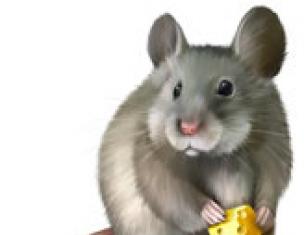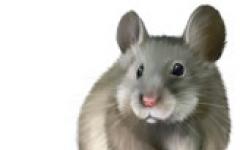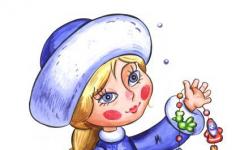Easter has been the main thing for many centuries religious holiday for Orthodox Christians. Fillet napkins with Easter themes have long been considered a wonderful gift for the Bright Resurrection of Christ, and were also used to decorate the table where the festive meal was held. They are good because any, even an inexperienced needlewoman can crochet Easter napkins with her own hands: the patterns can be very different, from the Christ is Risen napkins to funny multi-colored products with the image of painted eggs or Easter bunnies.
For easter decorations crochet is used in the fillet technique, imitating the lace of the same name. This type of needlework is very popular, since it does not require experience and special skills, thanks to which it is available to anyone who wishes. All you have to do is master a few basic tricks and practice a little.
After that, you can easily repeat almost any pattern shown in the diagram. In addition, such napkins are strong enough and hold their shape well, which allows them to be used to decorate the table. For an Easter napkin, it is best to choose natural yarn from cotton, linen, viscose and other combined types of yarn containing these fibers.
The fillet technique is based on working with a mesh and is an alternation of its empty and filled cells. Products are made according to schemes, where dark squares are filled cells, and light ones are empty. This drawing is quite simple.
If you have never crocheted, then before you start working on an Easter napkin, we recommend that you practice a little and knit a small piece like a checkerboard. This will help you train your hand and work out the principle of moving from empty cells to filled ones. In addition, trial knitting will make it possible to understand all the nuances of this process.
Square and round napkins
Easter napkins are usually made in two types: square and rounded, in the shape of an egg. The former are called "Easter towels". They are large enough (most often 64 × 31 cm), have rectangular shape and are made of light monochromatic yarn. On such napkins, in addition to the pattern, the letters "ХВ" are often depicted, as well as the silhouette of an Easter cake and a burning candle.
It is considered one of the simplest. It is recommended to start the work from the bottom edge and go to the top of the picture. Then, when the product is almost ready, its edges are tied with a curly border. With such an Easter towel, you can beautifully decorate a wicker basket or a dish with traditional festive treats: painted eggs and Easter cakes.
Round multi-colored napkins with. They look like several crocheted eggs, which, when combined into one napkin, form a pattern. Such fillet lace is considered more complicated, since many novice needlewomen do not understand the principle by which they need to start knitting a round mesh. In addition, it is quite difficult to maintain the correct silhouette here. At the same time, the plus of such products is that all their elements are made separately, and then fastened together. That is, if you make a mistake or get tangled up in loops, you do not have to dissolve all the work: it will be enough to redo just one small fragment.
Knitting a round napkin goes from the center to the outside edges. Make a ring of loops, the number of which depends on the pattern. Further, in accordance with the instructions, you need to knit the required number of columns coming from this ring. They are knitted without a crochet and with one lifting loop. Then continue working in a circle, gradually increasing the size of the sectors.
After you knit the center circle, you will need to separately make several eggs from the multi-colored yarn. Here you also need to start knitting from the center, but in the process of work it is very important to create an oval outline of the product in order to give it a resemblance to the silhouette of an egg. Then all that remains is the beautiful to connect all the elements.
How to properly starch napkins
Ready product crocheted does not always look good and hold its shape, so it is better to starch it. This must be done correctly, otherwise the napkin may completely lose its presentation and deform. The procedure is as follows.
- Place a flat tablespoon of starch in a wide, heat-resistant container.
- Add some water. You need so much liquid to bring the powder to a gruel state.
- Add a liter of boiling water to the container and put it on gas. The resulting mass should boil over low heat for about 5 minutes with constant stirring. As a result, you should get a thickened homogeneous solution, similar to jelly. Do not be intimidated by the cloudy appearance of the liquid, it should be so.
- Remove the solution from the heat and dip a napkin into it. If you knit it with thick threads, then keep the product in starch for 15 minutes, if with medium threads - 10. A napkin knitted from thin threads should be starchy for 5-6 minutes.
- Remove the product from the solution, spread it on a flat surface and let it dry.
If you are working not with a rectangular, but with a round napkin, consisting of many elements, then it is advisable to dry it in a special way. Spread the product on a flat surface and carefully secure the edges of the napkin with needles. So it will definitely not be deformed and will take on the correct shape.
Holiday Christ's resurrection traditionally, it is a family holiday, when all relatives gather at the festive table. Housewives bake Easter cakes and display baskets with dyes, pies, candles. All this variety looks very harmonious on textiles. self made, an example of which would be a crocheted Easter napkin.
Lace fantasy
Very beautiful and delicate napkins made with sirloin knitting, when with the help of air loops and double crochets, empty and "filled" squares are created. By alternating these squares, patterns and patterns are formed according to the principle of fillet lace, when cells were embroidered (filled) on the grid, forming a pattern. You can knit such napkins from threads of different colors, not only white.


Some options are shown below:



Such napkins can be not only with letters and symbols, but also with chickens, pigeons, ducks, and also made in the form of eggs.



Hanging napkins
This workshop describes a decorative Easter napkin on a pendant with a picture of a chicken. Such napkins are woven quickly and easily, they can be used to decorate tables and sideboards, as well as windows, hanging by a loop.

For work you will need:
- White yarn - 20 g;
- Peach yarn - 15 g;
- Bright yellow - 20 g;
- Pink - 10 g;
- Blue - 20 g;
- Raspberry - 15 g;
- Scissors;
- Hook number 2.

Knitting will be done according to the scheme below:
Inner part:
- row 1: we collect 6 air loops with white threads. and we knit them - it turns out 6 columns b / n;
- row 2: with bright yellow threads we knit from each column of the lower row two pillars b / n - 12 pillars b / n are obtained;
- row 3: pink threads we knit we repeat the pattern: "extended loop, 1 air loop.", to the end of the row, 6 petals are obtained from two elongated loops;
- row 4: we knit from each air loop. 3 p / columns to the end of the row;
- row 5: with raspberry yarn, the whole row is knitted with simple pillars, at the end of the row - 1 joint;
- row 6: thread peach blossom: 1 pp, 2 columns b / n, 2 VP over one column. bottom row, 2 columns b / n, 2 air loops and so on to the end, then 1 connecting loop.
Outer part:
- row 7: with white yarn we knit the whole row with two half-columns, 2 air loops, 2 p / pillar. etc. At the end of the row, we make 1 connecting loop, unfold the work and knit 11 columns with 2nak. over 2 arches of the lower row;
- row 8: with bright yellow threads we knit a beak: 3 pillars with nak., 1 air loop., 3 pillars with nak.;
- row 9: knit a scallop with raspberry yarn;
- row 10: with blue yarn we knit the last, wavy row of napkins: 3 semi / column, 1 column b / nak. in a row of peach color, 3 half columns. and so on to the very head.
Such a chicken napkin as a gift will delight family and friends.
Easter bunnies
Easter napkin crochet on the theme "Easter bunnies at the festive table."
Please note that the product will be 35 cm in diameter. You can adjust the required dimensions yourself.
Would need:
- white, blue, yellow and pink yarn "Iris" (about 40 g);
- satin ribbon 3-5 mm wide in light lettuce color (1 m);
- hook.

This napkin is decorated at the edges with six sectors - hares with baskets, which have gathered around a table consisting of six wedge-droplets. Each hare has its own wedge. Thus, the pattern will be repeated 6 times, and the sectors will be connected to each other by baskets. Each bunny consists of several parts: eyes, head, torso, ears.
Start knitting with threads white... Make a ring of 4 air loops. The next row is to tie 3 c. p., 11 art. s / n, connect. Then knit according to the presented scheme, closing each row with a connecting post. Having created two eyes, combine them into one piece, guided by the photo. Tie the body and ears as shown in the figure. Assemble the bunny from parts into one piece. Braid the silhouette of each with blue yarn with a single crochet over the head, use a pico harness on the body.
Connect the central part of the napkin - a yellow star with six rays, which will connect all sectors. Make a circle with air loops, and small rays of 12, large ones of 24 air loops of 6 pcs., Fix them in the middle, as well as fragments of the product, as shown in the diagram. Knit baskets from yellow threads and attach them to the main work.

Tie seven flowers from pink yarn, attach them to the center of the napkin, as well as to each basket. Flowers are knitted from rings made of 6 air loops. Then knit 7 arches from air loops, connect to the center with a single crochet.
Lightly starch the finished work, and when it dries, glue the black dots on the eyes of the bunnies.
Holidays always inspire creativity, so let your imagination and imagination not dry out, inventing new and interesting products.

Related videos
You can learn more about how to knit an Easter napkin with your own hands from the video tutorials at the end of the article.
A set of crocheted Easter napkins in a fillet method will become a worthy decoration when serving a festive meal. Each repeats the shape of an egg, made with a different motive and color. Iris yarn was chosen for all products, as the most decorative yarn in terms of yarn production. Consumption of yarn of one color 12 g. For all Easter napkins, crochet different schemes, you will need a satin ribbon in the color of the product.
The needlework is of the same size, 21.5 x 18 cm; the fillet method of work is used for the products. This type of knitting determines the fillet mesh as the base. Each square of the diagram includes three elements, that is, a column is used to create it, 2 air loops... If the square is filled, then it has two inner double crochets, two main side ones. Thus, various motives can be knitted inside the work, like an embroidered cross on a canvas.
A set of decorations for the festive table is made with various internal patterns and yarn colors, creating a rainbow with the same knitting techniques, sizes of all products.
Crochet pattern for a golden Easter napkin
Start knitting with a set of 25 c. n., including base, rise and 6 in. n. Then turn around and walk along vp. 7 conn. Art., 1 Art. s / n in the fifth free link of the chain, 14 double crochets connected to the base. The first row is knitted according to the scheme, which includes 5 sirloin cells. To expand the second row, you will need to continue c. 9pcs. (6 for cells, 3 lifting). Expand the work, knit 2 p. To do this, increase the strip according to the figure by 2 cells on both sides with the lower 6 loops.
Difficulties for novice needlewomen in crocheting an Easter napkin may arise in a further increase in the length of the strip by one cell. To create a fragment, you need to finish creating the previous row. 6 air loops, 3 for lifting, then turn the product over. At the end, the addition to the cell is performed by knitting another 3 tbsp / n from the base of the last column, which, when leveling the canvas, will give the desired expansion.
When decreasing a fragment, on one side, the required number of columns is not tied, on the other hand, retreat to the calculated distance using connecting columns. Remember the number of links per cell.
A graphic guide to the crochet Easter napkin pattern is given for knitting the middle part from the first to the last row, therefore, the lower marking 10 is considered as initial row work.
After the end of the motive, complete the transition to crocheting the border of the Easter napkin, work in a circle, ending each strip with a connection. Tie in a circle rapport 1 tbsp. b / n, 4 air. etc. in a circle. The second is to create an arch of 5 air. loops from the middle of the arch of the previous row. Pull 4 air loops through the arches. satin ribbon, tie a bow.
The set contains products made using the same technology, but each is characterized by its own individual internal pattern:
- lilac;
- light green;
- light blue;
- dark pink.
For each, a special motive for sirloin knitting is proposed, but the beginning of work, the order of knitting is identical. Each of them is woven into the border satin ribbon the same color as the main canvas.
Variants of all motives and the knitting pattern can be transferred to your computer by using the right mouse button and clicking on the task: "Save image as ..."
Crochet golden (orange) Easter napkin pattern
Crochet lilac Easter napkin scheme
Crochet light green Easter napkin scheme
Preparing for the Easter celebration is time-consuming. In order to have time to complete all the necessary preparations for a light celebration, many housewives begin to create some of the festive attributes in advance. For example, an Easter napkin can also be crocheted many months before an important Christian date.
We invite you to get acquainted with a very simple and accessible even for a beginner needlewoman, crocheting technique. This elementary crochet technique is called sirloin knitting.

Execution knitted products in the presented technique, it is completely uncomplicated and accessible for a craftswoman with any level of crochet proficiency. In knitting in this way, only air loops and ordinary double crochets are used. However, for all its seeming simplicity, the fillet knitting technique requires utmost care and perseverance when reading patterns in the knitting process.
Sirloin knitting is an imitation of fillet lace, which is an openwork embroidery on a net. In such a grid, the cells are filled with threads according to a special pattern. Knitting patterns using such unusual technique resemble cross stitch patterns.

Modern knitting and embroidery magazines offer the most various schemes and drawings for fillet technology, from simple and small ornaments, to paintings, subject canvases. However, to start knitting a complex pattern according to the pattern you like, you need to knit a sample: a small section of the grid, for example, ten cells in length and ten cells in height, and take a close look at it. First, it will allow you to mentally correlate the scale of your future product in relation to the existing fillet scheme. Otherwise, the conceived openwork napkin may eventually turn into a huge tablecloth. Here you need to take into account all the factors: both the thickness of the threads and the size crochet hook and the density of your knitting. The thinner the thread smaller size crochet and tighter knitting - the smaller the cage will turn out, and vice versa. Secondly, how close the resulting sample is to a square, that is, how smooth your grid is, and how square the windows in it are. Here you can make small adjustments to knitting, for example, knit a crochet shorter, tighter or, conversely, longer, reduce or increase the number of air loops.
After studying the features of the fillet knitting technique and reading the description of knitting motifs, you can start making an Easter napkin with your own hands.
We study a detailed and simple master class on crocheting an Easter napkin
We bring to your attention a similar master class on knitting an Easter napkin quickly and simply by crocheting.

To work you need a mercerized cotton yarn, "Iris". 2.5 grams of threads of various shades - dark green, young green, two shades of pink, yellow, blue and lilac. The finished napkin will be twenty-eight centimeters in diameter and shaped like a flower with petals.
Complete with a napkin will also Easter eggs with chickens. The pattern of knitting an Easter napkin using a regular crochet is shown in the photo below.
For the middle section, choose a dark green thread color. Start knitting in the center, making a ring of eight loops tied with seventeen single crochets and one lifting loop.
Further, according to the scheme, perform six rapports on the resulting ring according to the scheme, repeating the expansion of the sectors to five rapports. Finish each strip with a connection. Finish the work, and tie six multi-colored petals, connecting them to the central part in the indicated places. Start knitting each petal from the center, creating a slightly oval outline, imitating the shadow of the egg. Starch the finished product and dry on a hard and even surface. In this case, it is best to put all the fragments under a press so that they do not go in waves during the drying process.
Crochet the multi-colored mesh bags in the direction of the spiral in the amount of six pieces.
 As a result of such simple manipulations and actions, you will get an unusual and beautiful Easter party napkin... Such a napkin will become the main decoration of the festive table. Good luck with your needlework and creative inspiration!
As a result of such simple manipulations and actions, you will get an unusual and beautiful Easter party napkin... Such a napkin will become the main decoration of the festive table. Good luck with your needlework and creative inspiration!
A selection of thematic videos on the topic of the article
At the end of the article, we offer you a selection of interesting thematic videos for viewing. In the selected video materials, you can see the subtleties of making crocheted openwork napkins. We hope they are helpful to you. Happy viewing!
For those who crochet, it's easy to come up with gifts and presents for the holidays. For example, you can make DIY Easter napkins. They are good for decorating a festive table or present to the owners of the house, which they looked into on this bright day.
Filet napkin
It is recommended to take any pattern for cross stitching as its basis. It is clear that the drawing must correspond to the theme. It can be a cake or a willow twig, a candle or a painted egg, or perhaps a cross. Then it will turn out to be Easter
Fillet knitting means that a mesh is made with the help of double crochets. The filled cells of the pattern are instructed to fill the void with another column. This will create the desired pattern.
This Easter is already self-sufficient. But it is permissible to make it even more festive and elegant. This effect is achieved using beautiful border along the narrow edges of the product.
One example of how an Easter napkin can be decorated (crocheted) is shown in the diagram below. But you can choose something of your own.

Round napkin
For her, you will need to complete one central circle and seven smaller ones around. They will then need to be filled with patterns suitable for the occasion. These can be the letters X and B, as well as a cross and flowers. This approach allows you to get unique Easter napkins. It is not difficult to make them with your own hands, the main thing is to remember the technique by which it is necessary to tie the base of the circle.
Its beginning is in a set of five loops. The first row is formed by 5 air, air and two more columns, with only one crochet. The second is similar to the first, only in reverse order. First, 5 air and two columns with one crochet, air and two with two crochets.
The central circle is made of 42 similar rows; Easter napkins are based on it (crocheted). The small circle patterns are identical to him, only there will be 38 rows.
It is recommended to fill the central circle with a pattern in the form of a regular heptagon. You can start it from the center by dialing a ring of 8 loops. Its first row begins with three air, then two double crochets with a common top. 10 air and three double crochet with one top. Repeat until seven elements are formed from the columns, separated by 10 air loops.
Second row: 3 air loops, another (*) 4 air, single crochet in the middle of the chain of the previous row, air, one more single crochet. 4 airy, column with one crochet to the top of the triple column. Continue the pattern as described after the mark (*).
Connect the pattern with the circle using two They should start in an arch from one air and be attached to two adjacent arches of the circle.

Cross and testicle
Not only an Easter napkin can become a decoration of the festive table. The pattern of knitting an egg or a cross is simple, but what effect the product will have on guests.
An example of how to tie a testicle is the diagram below. This mini napkin can be used for table decoration or as a glass holder.

The circuit contains an element in the form of a triangle. Which means "pico", that is, three air loops and a connecting post in the first of them. All other elements are self-explanatory.

A needlewoman who wants her Easter napkin (crocheted) to be in the form of a large cross will need the following scheme. It shows in detail how to knit an openwork pattern.

Round napkin with bunnies
Its beginning is any flower pattern. It is desirable that it be completed on the seventh row. With the eighth row at the top of each petal, you need to tie three double crochets from one loop. Run 18 air between them. These columns will be the border for the petals, inside which the bunnies will be. The first seven rows of the pattern diverge, and then six - rounding is performed.
Around the bunnies that decorate the related Easter in the article), it is recommended to make arches from air loops. If the distance is very large, then attach the arches to each other to the previous row.
The bunnies themselves are obtained from double crochets. Their diagram can be seen in the photo below.

Napkin basket for colored eggs
The bottom of such a "basket" is a simple circle. It starts with 14 air loops, closed in a ring. On it, perform 31 double crochets. In the second row, crochet stitches need to be knitted every fourth. Separate them with four air loops.
The third consists mainly of double crochets, which are knitted into arches. There should be 7 of them. The gaps between them are filled with two air loops. Continue knitting the rows so that only one crochet remains by the seventh double crochet. And fill the space between them with small arches made of air loops.
The eighth row is recommended to be made only from arches. And tie the 9th and 10th with the same double crochet. In the 11th and 12th columns alternate with two air ones. In the 13th, the columns will have to be knitted with alternating three air loops.
The 14th row starts another pattern. In it, on every third column of the previous row, knit a triangle of two double crochets and three air loops. There should be 9 double crochets between them.
From the 15th to the 20th, the pattern is repeated, only between the triangles there will be first 11, then 13, 19, 23, 27 and 31 double crochets. The last 21st row is a strapping, which is performed with single crochets. In an arch of three air loops, there should be three such columns.

Crochet chicken
Not only an Easter napkin (crocheted) turns out to be a home decoration for a holiday. Alternatively, it is recommended to tie a voluminous chicken.
It is supposed to start knitting from the head. For her, dial a ring of 5-7 loops. The first row consists of 10 double crochets, alternating with an air loop. Second: two double crochets in each arch of the previous row.
You need two such circles. Tie them in single crochet with each other. Leave seven columns free on both circles. The knitting of the torso will begin from them.

The first row of the calf: columns with two crochets, alternating with an air loop. In the second, two columns with two crochets go after one air one. Moreover, the columns are made in the arches.
Third row: already three columns with two crochets alternate with two air loops. From the fourth, the difference in the breast and wings of the bird begins.
Half of the fourth row, which will be the breast, repeats what was in the third. And the second part consists of such triple columns, connected by two in each arch and separated by two air loops. So continue two more rows.
It remains to tie the tail of the chicken. First, two rows are arches made of air loops. The next row is 8 columns with two crochets, divided in pairs by pico.
To complete easter chicken by tying the scallop and beak.









